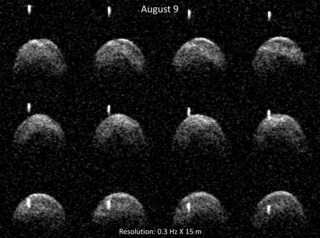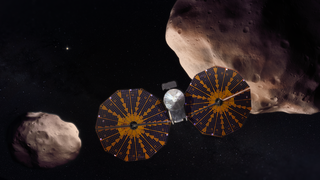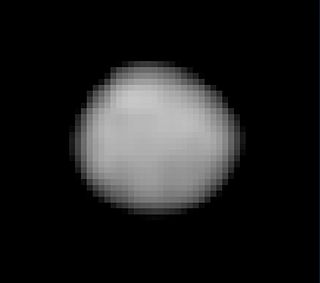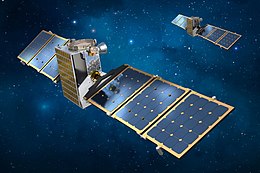
The Explorers program is a NASA exploration program that provides flight opportunities for physics, geophysics, heliophysics, and astrophysics investigations from space. Launched in 1958, Explorer 1 was the first spacecraft of the United States to achieve orbit. Over 90 space missions have been launched since. Starting with Explorer 6, it has been operated by NASA, with regular collaboration with a variety of other institutions, including many international partners.

The Discovery Program is a series of Solar System exploration missions funded by the U.S. National Aeronautics and Space Administration (NASA) through its Planetary Missions Program Office. The cost of each mission is capped at a lower level than missions from NASA's New Frontiers or Flagship Programs. As a result, Discovery missions tend to be more focused on a specific scientific goal rather than serving a general purpose.
The New Frontiers program is a series of space exploration missions being conducted by NASA with the purpose of furthering the understanding of the Solar System. The program selects medium-class missions which can provide high science returns.

Asteroids, including those in the asteroid belt have been suggested as a possible site of human colonization. Some of the driving forces behind this effort to colonize asteroids include the survival of humanity, as well as economic incentives associated with asteroid mining. The process of colonizing asteroids does have many obstacles that must be overcome for human habitation, including transportation distance, lack of gravity, temperature, radiation, and psychological issues.

65803 Didymos is a sub-kilometer asteroid and binary system that is classified as a potentially hazardous asteroid and near-Earth object of the Apollo group. The asteroid was discovered in 1996 by the Spacewatch survey at Kitt Peak, and its small 160-meter minor-planet moon, named Dimorphos, was discovered in 2003. Due to its binary nature, the asteroid was then named Didymos, the Greek word for 'twin'.

The Jupiter Icy Moons Explorer is an interplanetary spacecraft that was launched on 14 April 2023 from Guiana Space Centre in the French Guiana by the European Space Agency (ESA) with Airbus Defence and Space as the main contractor. The mission is planned to study Ganymede, Callisto, and Europa, three of Jupiter's Galilean moons. They are thought to have significant bodies of liquid water beneath their icy surfaces which would make them potentially habitable environments.

(35107) 1991 VH is a binary near-Earth asteroid and potentially hazardous asteroid of the Apollo group. It was discovered on 9 November 1991, by Australian astronomer Robert McNaught at Siding Spring Observatory. This binary system is composed of a roughly-spheroidal primary body about one kilometre in diameter, and an elongated natural satellite less than half a kilometre in diameter. The 1991 VH system is unusual for its dynamically excited state; the satellite has a tumbling, non-synchronous rotation that chaotically exchanges energy and angular momentum with its precessing, eccentric orbit. This asteroid system was one of the two targets of NASA's upcoming Janus Mayhem mission, until the delay of the rocket launch made both targets inaccessible.

(175706) 1996 FG3 is a carbonaceous asteroid and binary system, classified as near-Earth object and potentially hazardous asteroid of the Apollo group, approximately 1.7 kilometers (1.1 miles) in diameter. The primary has a spheroidal shape. Its minor-planet moon measures approximately 490 meters (1,600 feet) in diameter.
The Asteroid Impact and Deflection Assessment (AIDA) missions are a proposed pair of space probes which will study and demonstrate the kinetic effects of crashing an impactor spacecraft into an asteroid moon. The mission is intended to test and validate impact models of whether a spacecraft could successfully deflect an asteroid on a collision course with Earth.

VERITAS is an upcoming mission from NASA's Jet Propulsion Laboratory (JPL) to map the surface of the planet Venus in high resolution. The combination of topography, near-infrared spectroscopy, and radar image data will provide knowledge of Venus's tectonic and impact history, gravity, geochemistry, the timing and mechanisms of volcanic resurfacing, and the mantle processes responsible for them.

Psyche is a planned mission to explore the origin of planetary cores by orbiting and studying the metallic asteroid 16 Psyche. Lindy Elkins-Tanton of Arizona State University is the principal investigator who proposed this mission for NASA's Discovery Program. NASA's Jet Propulsion Laboratory (JPL) will manage the project.

Lucy is a NASA space probe on a twelve-year journey to eight different asteroids, visiting two main belt asteroids as well as six Jupiter trojans, asteroids which share Jupiter's orbit around the Sun, orbiting either ahead of or behind the planet. All target encounters will be flyby encounters. The Lucy spacecraft is the centerpiece of a US$981 million mission.
The selection process for Mission 13 and 14 of the Discovery program began in February 2014, as NASA drafted an Announcement of Opportunity (AO) for the next Discovery mission. The winning mission proposals received $450 million in funding towards mission development and construction, along with bonus funding if missions were able to incorporate certain technologies. For Discovery Mission 13 and 14, NASA received 28 proposals, 16 of which notably centered around small Solar System bodies. Lucy, a multiple-flyby mission to the Jupiter trojans, and Psyche, a mission to the metallic asteroid 16 Psyche, were announced as the winners of the competition in January 2017, with launches in October 2021 and October 2023, respectively.

Double Asteroid Redirection Test (DART) was a NASA space mission aimed at testing a method of planetary defense against near-Earth objects (NEOs). It was designed to assess how much a spacecraft impact deflects an asteroid through its transfer of momentum when hitting the asteroid head-on. The selected target asteroid, Dimorphos, is a minor-planet moon of the asteroid Didymos; neither asteroid poses an impact threat to Earth. Launched on 24 November 2021, the DART spacecraft successfully collided with Dimorphos on 26 September 2022 at 23:14 UTC about 11 million kilometers from Earth. The collision shortened Dimorphos' orbit by 32 minutes, greatly in excess of the pre-defined success threshold of 73 seconds. DART's success in deflecting Dimorphos was due to the momentum transfer associated with the recoil of the ejected debris, which was substantially larger than that caused by the impact itself.

The Planetary Missions Program Office is a division of NASA headquartered at the Marshall Space Flight Center, formed by the agency's Science Mission Directorate (SMD). Succeeding the Discovery and New Frontiers Program Office, it was established in 2014 to manage the Discovery and New Frontiers programs of low and medium-cost missions by third-party institutions, and the Solar System Exploration program of NASA-led missions that focus on prioritized planetary science objectives. The Discovery and New Frontiers programs were established in 1992 and 2001 respectively, and have launched fourteen primary missions together, along with two missions launched under the administration of the Planetary Missions Program Office. The Solar System Exploration Program was established alongside the office, with three missions planned for launch under the new program.

Athena was a proposed space mission that would have performed a single flyby of asteroid 2 Pallas, the third largest asteroid in the Solar System.

Dimorphos is a natural satellite or moon of the near-Earth asteroid 65803 Didymos, with which it forms a binary system. The moon was discovered on 20 November 2003 by Petr Pravec in collaboration with other astronomers worldwide. Dimorphos has a diameter of 177 meters (581 ft) across its longest extent and it was the target of the Double Asteroid Redirection Test (DART), a NASA space mission that deliberately collided a spacecraft with the moon on 26 September 2022 to alter its orbit around Didymos. Before the impact by DART, Dimorphos had a shape of an oblate spheroid with a surface covered in boulders but virtually no craters. The moon is thought to have formed when Didymos shed its mass due to its rapid rotation, which formed an orbiting ring of debris that conglomerated into a low-density rubble pile that became Dimorphos today.

Small Innovative Missions for Planetary Exploration (SIMPLEx) is a planetary exploration program operated by NASA. The program funds small, low-cost spacecraft for stand-alone planetary exploration missions. These spacecraft are intended to launch as secondary payloads on other missions and are riskier than Discovery or New Frontiers missions.



















